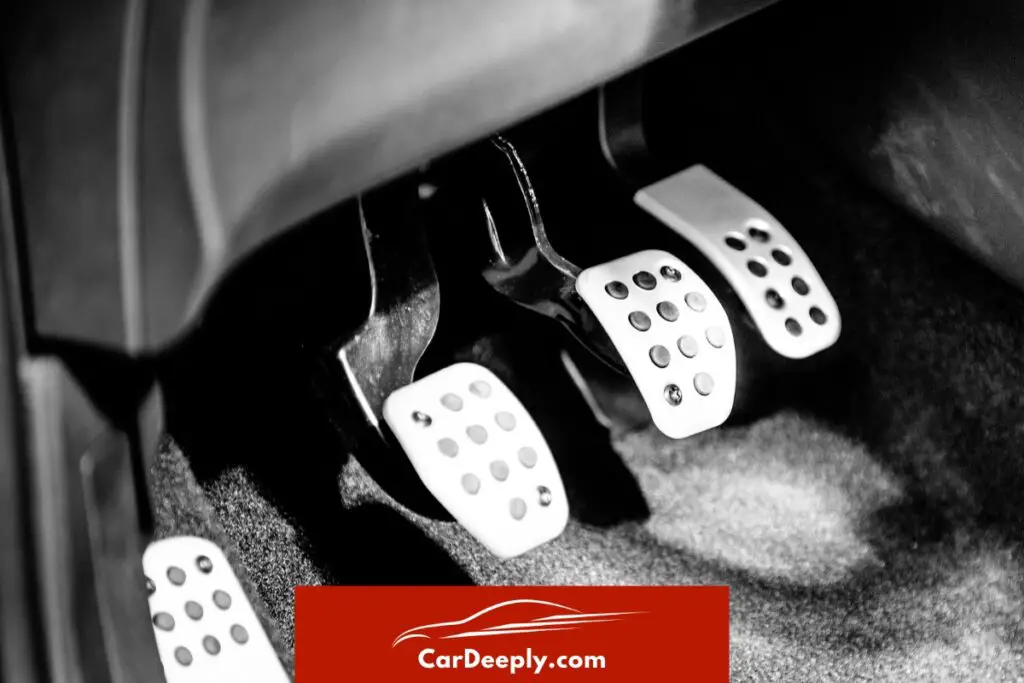“Dumping the clutch” – a phrase that can send shivers down the spine of any car enthusiast. It’s a practice that can lead to thrilling acceleration and costly damage if not done correctly.
This article is your comprehensive guide to understanding and safely executing this technique.
By reading on, you’ll benefit from the following:
- Unraveling the mechanics behind clutch dumping.
- Learning the potential risks and how to avoid them.
- Gaining practical tips for safe and effective clutch dumping.
So buckle up and let’s dive into the world of clutch dumping – your vehicle will thank you!
Advertising links are marked with *. We receive a small commission on sales, nothing changes for you.
Key Takeaways

- Dumping the clutch is a technique for rapid acceleration in manual cars.
- It involves releasing the clutch pedal suddenly at high RPMs.
- The technique can increase wear and tear on the car’s transmission.
- Dumping the clutch incorrectly can cause immediate damage to various car components.
- It’s a high-risk, high-reward technique that should be used sparingly and cautiously.
What is Dumping the Clutch?
Let’s start by grasping what “dumping the clutch” really means. It’s a term that’s thrown around a lot in the world of car enthusiasts, especially those who love the thrill of speed.
Dumping the clutch is a technique that fully engages the clutch pedal at high RPMs, then suddenly releases it.
This abrupt action causes the car to lurch forward, giving you that adrenaline-pumping acceleration.
What is a Clutch, and How Does it Work?
The Role of a Clutch in a Manual Transmission Car
Before we dive deeper into the art of clutch dumping, it’s crucial to understand the role of the clutch in a manual transmission car. The clutch is the unsung hero that connects your car’s engine to its transmission.
The magical component allows you to change gears and keep your engine running even when the vehicle is stationary.
Types of Clutches: Dry and Wet
There are two main types of clutches you’ll come across:
- Dry clutch
- Wet clutch
A dry clutch is the most common type found in cars and motorcycles. It operates in a dry environment, hence the name. On the other hand, a wet clutch is bathed in a cooling, lubricating fluid, making it less likely to overheat and wear out.
The Mechanism of Dumping the Clutch
Now that we’ve covered the basics let’s delve into the nitty-gritty of dumping the clutch. Dumping the clutch creates a sudden burst of power from the engine to the car’s drivetrain. This is achieved by revving the engine to high RPMs while the clutch is disengaged and suddenly releasing the clutch pedal.
The result?
A rapid transfer of power that can make your car shoot forward like a rocket. But remember, with great power comes great responsibility. This technique can be a double-edged sword, offering both exhilarating speed and potential damage to your car’s transmission if not done correctly.
In the next part, we’ll explore the pros and cons of dumping the clutch and how to do it safely to avoid causing unnecessary wear and tear to your car.
Stay tuned!
Benefits of Dumping the Clutch
Let’s start with the good stuff. Why would anyone want to dump the clutch? Well, there are a few reasons:
- Rapid acceleration
- Thrilling driving experience
- Useful in certain racing scenarios
The most obvious benefit is the rapid acceleration. When you dump the clutch, your car can shoot forward with a burst of speed that’s hard to match with standard driving techniques.
It’s a thrilling experience that can make you feel like a professional racer, even if it’s just for a few seconds.
Drawbacks of Dumping the Clutch
But it’s not all sunshine and rainbows. Dumping the clutch can have some serious drawbacks:
- Potential damage to the transmission
- Increased wear and tear
- Risk of engine stalling
The sudden transfer of power can put a lot of strain on your car’s transmission. Over time, this can lead to increased wear and tear and potentially costly repairs.
The engine stalling is also risky if the technique is not executed correctly.
Is Dumping the Clutch Bad for Your Car?
The short answer is it can be. The sudden shock of power can cause damage to various parts of your car, including the clutch itself, the gearbox, motor mounts, CV axles, and other driveline components.
It’s a high-risk, high-reward technique that should be used sparingly and cautiously.
Best Practices in Dumping the Clutch
If you’re going to dump the clutch, it’s important to do it right. Here are some tips:
- Practice in a safe environment
- Don’t overdo the RPMs
- Ensure your car is in good condition
Remember, safety comes first. Always practice in a safe and controlled environment, away from other vehicles and pedestrians. And make sure your car is in good condition before attempting this technique.
A vehicle with worn-out components is more likely to suffer damage from clutch dumping.
Common Mistakes People Make with Clutches
Finally, let’s look at some common mistakes people make when it comes to clutches and clutch dumping:
- Riding the clutch
- Dumping at too-high RPMs
- Not maintaining the clutch
Avoid these mistakes to prolong the life of your clutch and ensure a smooth and enjoyable driving experience.
Frequently Asked Questions
Can dumping the clutch cause immediate damage to my car?
While immediate damage can occur, especially if the clutch dumping is done incorrectly or at extremely high RPMs, typically, the damage accumulates over time. Frequent clutch dumping can increase wear and tear on your car’s drivetrain components.
Is there a specific RPM range safe for dumping the clutch?
There isn’t a one-size-fits-all answer to this, as it can depend on various factors like the type of car, the condition of the clutch, and the specific situation. However, as a general rule, it’s best to avoid dumping the clutch at extremely high RPMs to minimize potential damage.
Can I dump the clutch in an automatic car?
No, clutch dumping is a technique specific to manual transmission cars. Automatic cars don’t have a clutch pedal, so the concept of clutch dumping doesn’t apply.
How can I tell if my clutch is worn out?
Some signs of a worn-out clutch include difficulty changing gears, a burning smell, a noisy clutch, or the car not moving when the clutch is released. If you notice any of these signs, it’s best to get your vehicle checked by a professional.
Can I modify my car to make it safer to dump the clutch?
Certain modifications, like upgrading to a performance clutch or strengthening the drivetrain components, can help withstand the stress caused by clutch dumping. However, these modifications can be costly and should be done by a professional to ensure they’re done correctly.
Conclusion
Dumping the clutch can be a thrilling technique for achieving rapid acceleration but it comes with risks.
By understanding these risks and following best practices, you can enjoy the thrill of speed while minimizing potential damage to your car. Drive safe!

Sebastian loves convertibles and drove a BMW 335i for a long time (325 hp is just a dream). Today, with two children, he is more concerned with SUVs and family-friendly vehicles. In addition to an Audi A4 Avant, he also drives a Cupra Formentor VZ – even as a family man, you can’t do without speed. Get to know Sebastian better and visit the About Us page.
Advertising links are marked with *. We receive a small commission on sales, nothing changes for you.
